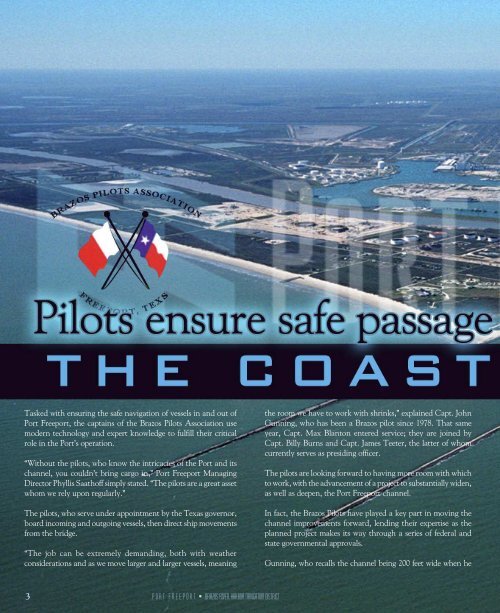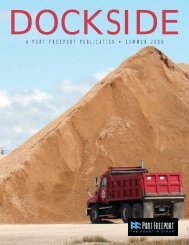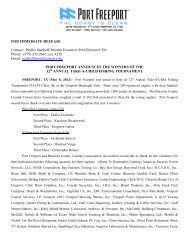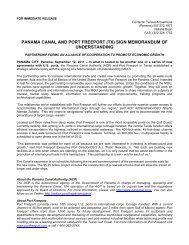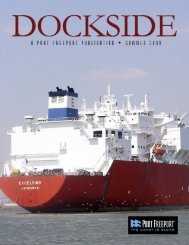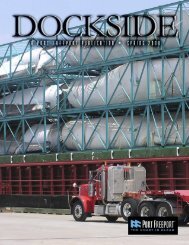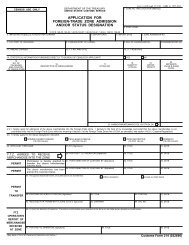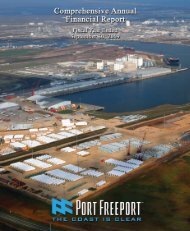brazos river harbor navigation district - Port Freeport
brazos river harbor navigation district - Port Freeport
brazos river harbor navigation district - Port Freeport
- No tags were found...
Create successful ePaper yourself
Turn your PDF publications into a flip-book with our unique Google optimized e-Paper software.
Tasked with ensuring the safe <strong>navigation</strong> of vessels in and out of<strong>Port</strong> <strong>Freeport</strong>, the captains of the Brazos Pilots Association usemodern technology and expert knowledge to fulfill their criticalrole in the <strong>Port</strong>’s operation.“Without the pilots, who know the intricacies of the <strong>Port</strong> and itschannel, you couldn’t bring cargo in,” <strong>Port</strong> <strong>Freeport</strong> ManagingDirector Phyllis Saathoff simply stated. “The pilots are a great assetwhom we rely upon regularly.”The pilots, who serve under appointment by the Texas governor,board incoming and outgoing vessels, then direct ship movementsfrom the bridge.“The job can be extremely demanding, both with weatherconsiderations and as we move larger and larger vessels, meaningthe room we have to work with shrinks,” explained Capt. JohnGunning, who has been a Brazos pilot since 1978. That sameyear, Capt. Max Blanton entered service; they are joined byCapt. Billy Burns and Capt. James Teeter, the latter of whomcurrently serves as presiding officer.The pilots are looking forward to having more room with whichto work, with the advancement of a project to substantially widen,as well as deepen, the <strong>Port</strong> <strong>Freeport</strong> channel.In fact, the Brazos Pilots have played a key part in moving thechannel improvements forward, lending their expertise as theplanned project makes its way through a series of federal andstate governmental approvals.Gunning, who recalls the channel being 200 feet wide when hejoined the Brazos Pilots nearly three decades ago, noted that it iscurrently 400 feet wide. The improvements would widen and deepenthe channel.The channel improvements are particularly important as <strong>Port</strong><strong>Freeport</strong> anticipates the new <strong>Freeport</strong> LNG Quintana Terminalto receive its first mammoth tanker shipment of liquefied naturalgas by late 2007.Last year, the Brazos Pilots began benefiting from a new electronicsystem that uses a buoy-mounted offshore current-monitoring deviceto provide real-time information to pilots’ laptop computers.The Brazos Pilots have a pair of 65-foot-long, aluminumhulledboats with twin diesel engines that facilitate speedsof up to 23 knots.Typically, a pilot rides one of the boats from the dock out tomeet an entering vessel outside the sea buoy, about 3 miles offthe beach. The pilot climbs a rope ladder to board the vessel,goes to the bridge and directs the movement of the vessel intoport. He does not disembark until the vessel is safely securedat the dock.A similar procedure, in reverse, is used by pilots in guidingdeparting vessels.“Our main role is as the local experts with specificknowledge of the currents, shoaling, weather conditionsand all of the aspects related to the <strong>navigation</strong> of vesselsin our waterway,” Gunning said. “We serve as a guardianfor the <strong>Port</strong>, ensuring the safe <strong>navigation</strong> of all vesselsentering and leaving the <strong>Port</strong>.”3 P O R T F R E E P O R T • BRAZOS RIVER HARBOR NAVIGATION DISTRICT P O R T F R E E P O R T • BRAZOS RIVER HARBOR NAVIGATION DISTRICT 4


